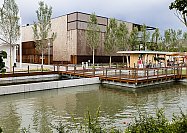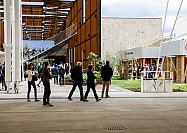For a good browsing experience we recommend using the latest version of Chrome, Firefox, Safari, Opera or Internet Explorer.
MEDIA
MEDIA. NEWS.
BRAZIL’S PAVILION FEATURES CORK FAÇADE AT THE MILAN EXPO
June 3, 2015Widely renowned for its unconventional design - where scenographic elements are closely linked with architectural patterns - the tradition of using cork in major international exhibitions is renewed in the Brazilian Pavilion
Corticeira Amorim has manufactured 1000 m2 of expanded insulation cork board - MD Façade for the Brazilian Pavilion at the Milan Expo, which will be running until 31st October. "Feeding the Planet, Energy for Life" is the core theme of the Milan Expo 2015 that will host 140 countries. It is estimated that some 20 million visitors will arrive in Milan during the 184 days of the Expo.
Expanded insulation cork board - MD Façade was selected not only for its sustainability credentials - which are extremely important in a building of a transient nature - but also for its ability to ensure the insulation of a temporary pavilion and for fitting in with the profile of the project designed by Arthur Casas Studio and the Marko Brajovic Atelier, with the collaboration of the Italian Mosae Studio.
According to architect Dario Pellizzari (Mosae Studio): "The choice of expanded insulation cork board - MD Façade allows us to offer an innovative solution, which is only 80-mm thick, but provides a good level of thermal insulation. In addition, this is a 100% natural raw material, whose use has no negative impact in terms of greenhouse gas effect."
Brazil's Expo Pavilion consists of two adjacent buildings with distinctive features: there is an open gallery, made of steel, with a tensile netted structure positioned at half height, allowing visitors to observe Brazil's typical biodiversity under their feet on the ground below. There is also a second closed building, completely covered with expanded insulation cork board. When subject to weather conditions, this material becomes slightly lighter, a perfect match for the rusty coloured steel.
Sustainability was a critical criterion in the selection of this material, said Luisa Basiricò, one of the consultants to the Brazilian Pavilion: "As this is a temporary building, we've tried to select materials that can be reused or recycled. Therefore, we've opted for mechanically fastening the cork panels to the façade of the building. Thus, the panels can later be removed and used in other projects or even in the same pavilion, if it will be opted for relocating the pavilion in a post-Expo context."
And, in line with a leading trend in interior design, cork is also used in indoor furniture in the Brazilian Pavilion. In fact, a set of cork modular sofas with headrest has been designed by the Mosae Studio. The modules are placed side-by-side, making up a large sofa with more than 20 meters long.
Carlos Manuel Oliveira, General Manager of Amorim Cork Insulation, said: "After the successful participation in the Hannover Expo in 2000 and, more recently, in the Shanghai Expo, where Portugal's Pavilion was one of the most visited and received the Design Award, it is our great pleasure to see that expanded insulation cork board has been selected again to be used as a structural element in a pavilion - this time at the Milan Expo." And he added: "Although Portugal is not officially represented at the Milan Expo, one of our country's most representative materials is in the spotlight at the event through our association with Brazil's Pavilion."
Since the opening of the Expo, the Brazilian Pavilion has been one of the most popular attractions at the event. It is a good example of a building where sustainability is everywhere, showing that it is possible to design good buildings that have reduced environmental impact.

